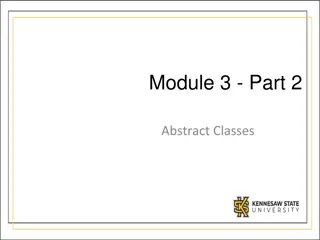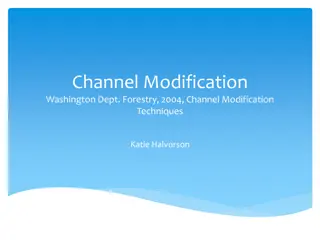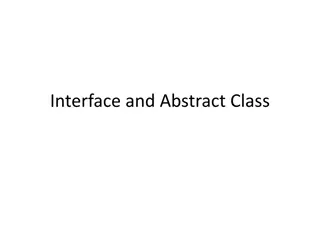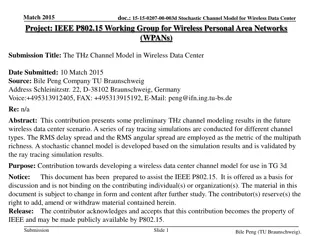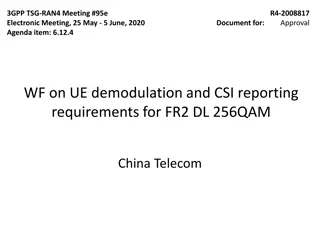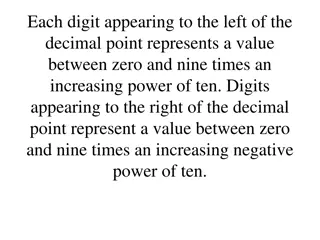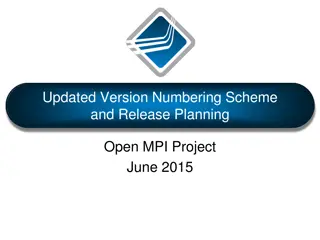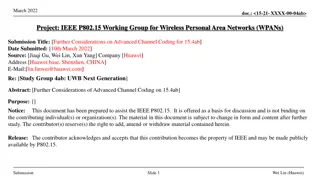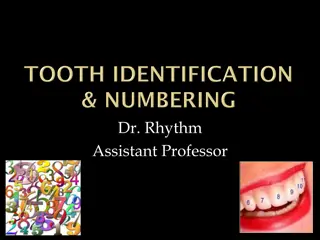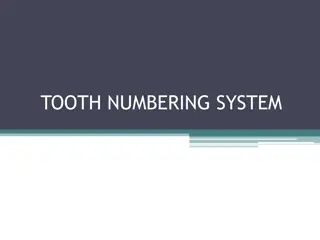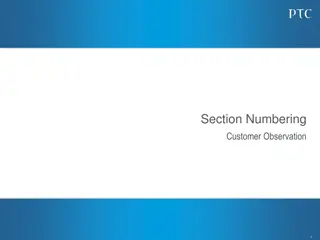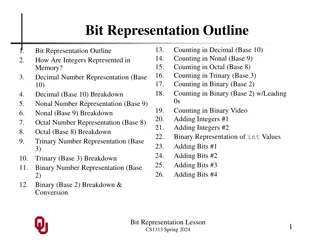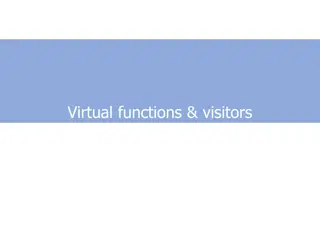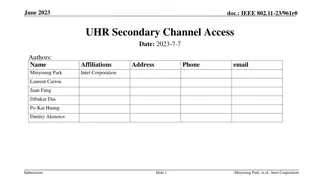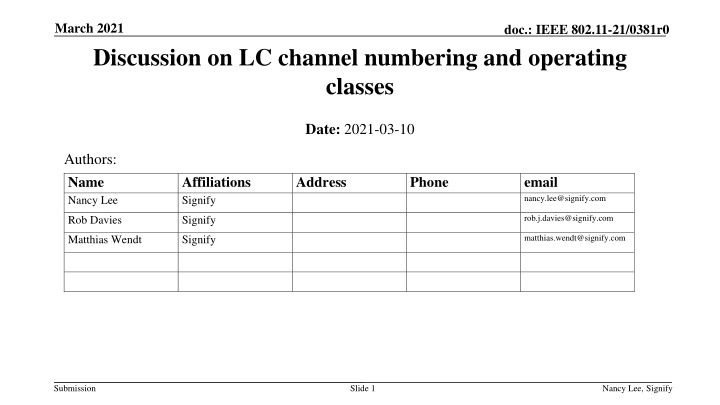
Discussion on LC Channel Numbering and Operating Classes in IEEE 802.11-21/0381r0
This presentation delves into the comparison of LC channel numbering in P802.11bb D0.3 with channel numbering and the utilization of operating classes in the current 802.11 standard. It analyzes the LC HE channel numbering and channelization in the context of 802.11bb, discussing implications, defined bandwidths, potential future enhancements, and alignment with 802.11ax channelization for enhanced compatibility. The document also highlights the intricacies of channel number transmission between STAs, in signaling and beacon frames, emphasizing alignment with 802.11ax channelization standards for efficient implementation and compatibility across varying RF bands and chip outputs.
Download Presentation

Please find below an Image/Link to download the presentation.
The content on the website is provided AS IS for your information and personal use only. It may not be sold, licensed, or shared on other websites without obtaining consent from the author. If you encounter any issues during the download, it is possible that the publisher has removed the file from their server.
You are allowed to download the files provided on this website for personal or commercial use, subject to the condition that they are used lawfully. All files are the property of their respective owners.
The content on the website is provided AS IS for your information and personal use only. It may not be sold, licensed, or shared on other websites without obtaining consent from the author.
E N D
Presentation Transcript
March 2021 doc.: IEEE 802.11-21/0381r0 Discussion on LC channel numbering and operating classes Date: 2021-03-10 Authors: Name Nancy Lee Affiliations Signify Address Phone email nancy.lee@signify.com rob.j.davies@signify.com Rob Davies Signify matthias.wendt@signify.com Matthias Wendt Signify Submission Slide 1 Nancy Lee, Signify
March 2021 doc.: IEEE 802.11-21/0381r0 Abstract This presentation discusses the LC channel numbering in P802.11bb D0.3 in comparison with channel numbering and the use of operating classes in the current 802.11 standard. Submission Slide 2 Nancy Lee, Signify
March 2021 doc.: IEEE 802.11-21/0381r0 CHANNEL NUMBERING Submission Slide 3 Nancy Lee, Signify
March 2021 doc.: IEEE 802.11-21/0381r0 Current 802.11bb LC HE channel numbering LC HE channelization [1] implies an LC operating band from 16 to 336 MHz Channel bandwidths of 20 MHz to 160 MHz are defined 320 MHz bandwidth may be added in the future Submission Slide 4 Nancy Lee, Signify
March 2021 doc.: IEEE 802.11-21/0381r0 Channel number is sent between STAs in signaling Channel number is sent in beacon frame Also used in other situations Aligning LC channelization with 802.11ax channelization may facilitate using 802.11ax chips for LC implementation Compatibility between implementations using 11ax chips with output in different RF bands or at baseband Compatibility with 11ax equations relating channel number to starting frequency and bandwidth Submission Slide 5 Nancy Lee, Signify
March 2021 doc.: IEEE 802.11-21/0381r0 802.11ax channelization (27.3.23 Channel numbering) The STA may operate in the 2.4 GHz band, 5 GHz band or 6 GHz band. The set of valid operating channel numbers by regulatory domain is defined in Annex E. Channelization is different for each band. Each relates channel number to starting frequency and bandwidth. In all cases channel center frequencies are defined at every integer multiple of 5 MHz e.g. for 5 GHz where (19-88) Channel starting frequency is defined as dot11ChannelStartingFactor 500 kHz or is defined as 5.000 GHz for systems where dot11OperatingClassesRequired is false or not defined. A channel center frequency of 5.000 GHz shall be indicated by dot11ChannelStartingFactor = 8000 and nch = 200. Submission Slide 6 Nancy Lee, Signify
March 2021 doc.: IEEE 802.11-21/0381r0 No perfect alignment for LC channel numbering Approach 1: Align with 5 GHz band channel numbering Use channels 36 - 96 (for contiguous 320 MHz range) or channels 36 - 64, 100 - 128 (to match 5 GHz numbering) But: Channels 68 - 96 are not defined in Annex E of [5] so unclear if 5 GHz radios support them. Also doesn t align with a 6 GHz radio s contiguous channel numbering An LC STA using a 6 GHz radio would need to change 6 GHz radio s channel starting frequency from 5.950 GHz to 5.775 GHz to align with this channel numbering channel numbers 36 are not supported by 2.4 GHz radios (see Equation (19-87) in 19.3.15.2 Channel allocation in the 2.4 GHz Band [4]) Approach 2: Align with 6 GHz channel numbering Channels 1 to 61 (for contiguous 320 MHz range) But: A 5 GHz radio may not support Channel 1 (Ch 36 = 5.180 GHz; Ch 1 = 5.005 GHz). Solution: shift channel numbering by changing the 5 GHz radio s channel starting frequency from 5.000 GHz to 5.175 GHz A 5 GHz radio might not be capable of supporting a contiguous 320 MHz band 2.4 GHz radios could use channels 1, 5, 9, 13 for 20 MHz channels (and 3 and 11 for 40 MHz channels) Submission Slide 7 Nancy Lee, Signify
March 2021 doc.: IEEE 802.11-21/0381r0 Approach 1 for LC HE channel numbering Channel number 36 38 40 42 44 46 48 50 52 54 56 58 60 62 64 Frequency range (MHz) 16-36 16-56 36-56 16-96 56-76 56-96 76-96 16-176 96-116 96-136 116-136 96-176 136-156 136-176 156-176 16-336 176-196 176-216 196-216 176-256 216-236 216-256 236-256 176-336 256-276 256-296 276-296 256-336 296-316 296-336 316-336 fc (MHz) 20 MHz 40 MHz 80 MHz 160 MHz 26 36 46 56 66 76 86 96 106 116 126 136 146 156 166 176 186 196 206 216 226 236 246 256 266 276 286 296 306 316 326 20 Align with 5 GHz band channel numbering (see 19.3.15.3 Channel allocation in the 5 GHz band [4]) - Channel 36-64 for lower 160 MHz - Channel 68-96 for upper 160 MHz or a subset of Channel 100-144 for upper 160 MHz - Aligns with 5 GHz operating classes but complicates LC implementations using conversion from 5 GHz RF - Step size 4 for channel bandwidths of 20 MHz (36, 40, 44, 48, etc.) 40 20 80 20 40 20 160 20 40 20 80 20 40 20 68/100 70/102 72/104 74/106 76/108 78/110 80/112 82/114 84/116 86/118 88/120 90/122 92/124 94/126 96/128 20 40 20 80 20 40 20 160 20 An LC STA using a 6 GHz radio would need to adjust its starting frequency, where Starting frequency = dot11ChannelStartingFactor 500 kHz 40 20 80 20 40 20 Submission Slide 8 Nancy Lee, Signify
March 2021 doc.: IEEE 802.11-21/0381r0 Approach 2 for LC HE channel numbering Channel number 1 3 5 7 9 11 13 15 17 19 21 23 25 27 29 Frequency range (MHz) 16-36 16-56 36-56 16-96 56-76 56-96 76-96 16-176 96-116 96-136 116-136 96-176 136-156 136-176 156-176 16-336 176-196 176-216 196-216 176-256 216-236 216-256 236-256 176-336 256-276 256-296 276-296 256-336 296-316 296-336 316-336 fc (MHz) 20 MHz 40 MHz 80 MHz 160 MHz 26 36 46 56 66 76 86 96 106 116 126 136 146 156 166 176 186 196 206 216 226 236 246 256 266 276 286 296 306 316 326 20 Align with 6 GHz band channel numbering (see 27.3.23.2 Channel allocation in the 6 GHz band [5]) - Channel 1 for first 20 MHz wide channel - Step size 4 for channel bandwidths of 20 MHz (1, 5, 9, 13, etc.) 40 20 80 20 40 20 160 20 40 20 80 20 40 20 33 35 37 39 41 43 45 47 49 51 53 55 57 59 61 20 An LC STA using a 5 GHz radio would need to adjust its starting frequency, where Starting frequency = dot11ChannelStartingFactor 500 kHz 40 20 80 20 40 20 160 20 40 20 80 20 40 20 Submission Slide 9 Nancy Lee, Signify
March 2021 doc.: IEEE 802.11-21/0381r0 OPERATING CLASSES Submission Slide 10 Nancy Lee, Signify
March 2021 doc.: IEEE 802.11-21/0381r0 Current 802.11bb LC HE channel numbering P802.11bb D0.3 [1] channelization implies an LC operating band from 16 to 336 MHz Channel bandwidths of 20 MHz to 160 MHz are defined 320 MHz bandwidth may be added in the future But: An LC STA may not support all channels and bandwidths in this operating band Submission Slide 11 Nancy Lee, Signify
March 2021 doc.: IEEE 802.11-21/0381r0 Supported frequency range and channel bandwidths may vary Hardware based on 2.4 GHz radios can support at most frequency range 16 MHz to 96 MHz and channel bandwidths up to 40 MHz Hardware based on 5 GHz radios may reflect regulatory limitations on 5 GHz operation that vary somewhat by country Noncontiguous frequency ranges for 802.11 operation with varying power levels, for example in the US [2, 3]: Channel numbers 36-64 (5170-5330 MHz) Channel numbers 100-144 (5490-5730 MHz) Channel numbers 149-165 (5735-5835 MHz) Some channels are subject to Dynamic Frequency Selection (DFS) to use frequencies generally reserved for radars. Capabilities may also be limited by the OFE Submission Slide 12 Nancy Lee, Signify
March 2021 doc.: IEEE 802.11-21/0381r0 Indicating supported frequency range and channel bandwidth in 802.11 An 802.11 STA can use the Country element to specify the exact set of channel numbers and bandwidths it supports. These may be expressed in terms of (subsets of) operating classes. For details see 9.4.2.8 Country element [4],[5]. An operating class value: Is defined in normative Annex E Specifies: a set of frequencies and corresponding channel numbers (defined in PHY clauses) the channel center frequencies that may be used (defined in PHY clauses) the maximum channel width that may be used behavioral constraints listed in Table D-2 (Behavior limits) Submission Slide 13 Nancy Lee, Signify
March 2021 doc.: IEEE 802.11-21/0381r0 Possible Operating classes for LC Add to table E-4 (operating class values to be confirmed): Operating class Non-global operating class Channel start frequency (GHz) Channel spacing (MHz) Channel set Behaviour limits set 140 - 0.021 20 1, 5, 9, 13, 17, 21, 25, 29, 33, 37, 41, 45, 49, 53, 57, 61 Near Infrared 141 - 0.021 40 3, 11, 19, 27, 35, 43, 51, 59 Near Infrared 142 - 0.021 80 7, 23, 39, 55 Near Infrared 143 - 0.021 160 15, 47 Near Infrared (144) - 0.021 320 31 Near Infrared Notes: LC channel start frequency 0.021 GHz => Channel 1 center frequency = 26 MHz If using a 2.4 GHz radio for LC, use channel start frequency = 2.407 GHz If using a 5 GHz radio for LC, use channel start frequency = 5.175 GHz If using a 6 GHz radio for LC, use channel start frequency = 5.950 GHz Submission Slide 14 Nancy Lee, Signify
March 2021 doc.: IEEE 802.11-21/0381r0 Summary At a minimum, LC channel numbers should be integers with step size = 4 for channel bandwidths of 20 MHz. Aligning LC channelization with 802.11ax channelization may facilitate using 802.11ax chips for LC implementation, but perfect alignment is not possible. May have to make tradeoffs, e.g. between facilitating implementations using existing 802.11ax chips vs. future evolution of LC Would 11ax chipsets be able to support channel numbers and dot11ChannelStartingFactor values different from those used for 5 GHz and 6 GHz bands? Are operating needed for LC operation and if so, should 11bb use existing operating classes or define its own? Would existing 11ax chipsets be able to support new operating classes if defined for LC operation? Submission Slide 15 Nancy Lee, Signify
March 2021 doc.: IEEE 802.11-21/0381r0 References [1] P802.11bb D0.3 [2] Code of Federal Regulations Title 47 - Telecommunication Part 15 - Radio Frequency Devices Subpart E - Unlicensed National Information Infrastructure Devices Paragraph 15.407 - General technical requirements [3] U-NII Bands: New Rules vs. Old Rules Part 15.407 (fcc.gov) [4] P802.11-REVmd D5.0 [5] P802.11ax D8.0 Submission Slide 16 Nancy Lee, Signify



